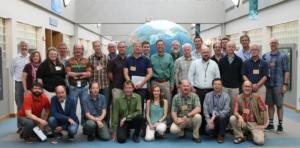
The team’s primary responsibility is to conduct Landsat-based scientific research and engineering studies, develop useful data products and applications and share the results of its work with the USGS, NASA and others. Members will serve a five-year term from 2018 to 2023.
The new team will conduct scientific research on technical issues critical to the success of the overall Landsat mission, including topics related to data acquisition, product access and formats, new science datasets, practical data applications to be derived from an operational system and other science opportunities for new and past-generation Landsat data.
Members will evaluate the quality of data when Landsat 9 is launched, which is estimated for December 2020, and help ensure that Landsat 9 data can be successfully integrated into the overall Landsat record. They will also be on the ground floor of discussions for future Landsat missions.
In addition, the new team may be called on to assess the viability of Landsat 7 data for scientific or operational purposes as the satellite nears its nineteenth year in orbit. They will also be responsible for looking at opportunities to develop new and advanced applications of Landsat data.
“This oncoming team is really in a pivot-to-the-future mode, as previous team contributions led to significant advancements that give the Landsat program a stronger long-term foundation,” said Thomas Loveland, chief scientist at the USGS Earth Resources Observation and Science Center and co-chair for the Landsat Science Team.
Previous Landsat Science Teams helped increase the ease of use and expand the utility of Landsat data for users across the nation; greatly increased the size of the Landsat archive by transferring historical data held by international cooperators; and advanced the breadth and accuracy of applications of the 45-year Landsat record.
“After four decades, Landsat remains a core resource for land science, and now we have a chance to think strategically about how the program should evolve over the next decades,” said Jeff Masek, Landsat 9 project scientist with the NASA Goddard Space Flight Center.
The 2018-2023 USGS-NASA Landsat Science Team members and their areas of study are:
Dr. Martha Anderson and Dr. Feng Gao, USDA Agricultural Research Service
— Characterizing crop water use, phenology and yield at field scales using multi-sensor data fusion
Mr. Noel Gorelick, Google
— Driving cloud-based usage of Landsat with Google Earth Engine
Dr. Matthew Hansen, University of Maryland
— Generating time-series maps that accurately reflect land change area: A strategy for global land monitoring
Dr. Sean Healey, U.S. Forest Service
— Landsat science and applications in the U.S. Forest Service
Dr. Patrick Hostert, Humboldt University of Berlin
— Synergies between future Landsat and European satellite missions, from land cover to land use
Dr. Justin Huntington, Desert Research Institute
— Towards the development and integration of Landsat evapotranspiration ensembles and climate data for enhanced water and land management decision support
Mr. David Johnson, USDA National Agricultural Statistics Service
— Leveraging analysis ready Landsat products for use in crop production estimation
Dr. Leo Lymburner, Geoscience Australia
— Digital Earth Australia
Dr. Alexei Lyapustin, NASA Goddard Space Flight Center
— Advanced atmospheric correction of Landsat 8/Sentinel 2 data using algorithm Multiangle Implementation of Atmospheric Correction
Dr. Nima Pahlevan, Science Systems and Applications, Inc.
— Landsat-Sentinel-2 constellation for monitoring aquatic systems across the United States
Mr. Jean-Francois Pekel and Dr. Peter Strobl, European Commission Joint Research Centre
— Copernicus Landsat convergence, architecture and applications
Dr. Volker Radeloff, University of Wisconsin
— Landsat data for biodiversity science and conservation
Dr. David Roy, South Dakota State University
— Pathfinding near real time moderate resolution land surface monitoring, looking forward to an operational Landsat 9/10 Sentinel 2A/2B era
Dr. Ted Scambos, University of Colorado
— Landsat and the cryosphere: Tracking interactions between ice, snow and the earth system
Dr. Crystal Schaaf, University of Massachusetts, Boston
— Global 30m snow and snow-free land surface albedo from Landsat and Moderate Resolution Imaging Spectroradiometer/Visible Infrared Imaging Radiometer Suite
Dr. Eric Vermote, NASA Goddard Space Flight Center
— Maintenance and refinement of the Land Surface Reflectance Code for Landsat and Sentinel 2
Dr. Curtis Woodcock, Boston University
— New opportunities using the Landsat temporal domain: Monitoring ecosystem health, condition and use
Dr. Michael Wulder, Canadian Forest Service
— Integrating time and space with Landsat to learn from the past, monitor the present and prepare for the future
Dr. Zhe Zhu, Texas Tech University
— Toward near real-time monitoring and characterization of land surface change for the conterminous United States
Further Reading: [added Jan. 16, 2018]
+ UMass Boston’s Crystal Schaaf to Continue Serving as Landsat Science Team Member, College News Updates
+ Hostert, Radeloff and Schaaf selected for new Landsat Science Team, Global Land Programme

Be Part of What’s Next: Emerging Applications of Landsat at AGU24
Anyone making innovative use of Landsat data to meet societal needs today and during coming decades is encouraged to submit and abstract for the upcoming “Emerging Science Applications of Landsat” session at AGU24.





